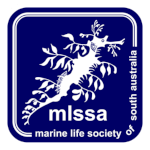A STUDY OF PORT ADELAIDE’S ANCHORS
by Steve Reynolds
Every ship needs an anchor, yet anchors do not normally get the recognition that they deserve. Despite that, an anchor is the most recognizable shipwreck artefact, and it is anchors that provide us with the best seafaring memorials.
Several different historical anchor designs can be seen at seafaring memorials on land around Port Adelaide and the Lefevre Peninsula. Some of these anchors are more ‘historical’ than others. Little was known about many of these anchors so, whilst helping to establish the Marine Life Society of South Australia’s Port Adelaide Anchor Trail 1, I attempted to find out as much about them as I possibly could.
DESCRIPTION OF AN ANCHOR
Wikipedia describes an anchor as “a device, normally made of metal, used to connect a vessel to the bed of a body of water to prevent the craft from drifting due to wind or current”. 2
According to “The Anchor, Fishery Bay, Eyre Peninsular” by Peter Kentish, Terry Drew and Brenton Booth (The Society for Underwater Historical Research)3: –
“An early vessel’s safety depended greatly upon the anchor and obviously they were of great importance. Consequently, a large amount of development and care was afforded to the construction and manufacture of an anchor.”
HISTORY OF ANCHORS AND DEVELOPMENT OF ANCHOR DESIGN
Anchors have been used throughout the ages to secure ships and boats to the seabed. The earliest known ‘anchors’ were made of stone. There are now different anchors for different uses. Anchor design has changed much over the years. Different anchor designs have many different features.
According to Types of Anchors – Stocked Anchors (http://ekaship.com/info/anchorchain/types-of-anchors-stocked-anchors-13581.html 4: –
The anchor was first named as “ancora” by the Greeks. ‘Ancora’ itself comes from the Greek ‘ἄγκυρα’. It meant ‘curved or hooked’.
Phoenician, Chinese, Greek and Roman seafarers all “used anchors as a means of saving a vessel caught on a lee shore”.
When Lake Nemi in Italy was drained between 1929 & 1931, first century AD Roman wooded anchors with both lead and iron stocks were recovered.
(Stocked anchors have a bar, called a stock, attached to the shank. The stock is fitted at right angles to the plane of the arms. It ensures that one of the anchor arms and flukes sink into the seabed (whilst the stock itself lays horizontal) when it is deployed on the seafloor. Anchor stocks have been designed in different sizes and shapes, and even in different positions, over the centuries. They are, however, usually located at the upper end of the shank. They are usually made of either wood or iron.)

A large iron stocked anchor
The early (wooden) stocks were usually made of two pieces of timber bolted and banded together. Iron stocks only came into general use in the 19th century when the Royal Navy (British) began to use small anchors with them.
Most anchors during the late 16th or early 17th Century had curved arms. As larger anchors were required, however, anchors with straight arms were introduced for English vessels. The stock of the anchor was made from timbers bound with iron hoops.
“A Sea Grammar” by Captain John Smith (London, 1627)5 included a list of the different types of anchors used by ships at that time:
“The ‘kedger’ anchor – the smallest of the anchors used in calm weather”
“The ‘stream’ anchor – only a little larger, used in an easy tide/stream”
“The ‘bow’ anchor – larger (4 in total)”
“The ‘sheet’ anchor – the largest and heaviest of all, used in emergencies”
“A Sea Grammar”5 also stated, “Anchor weight was in proportion to the size of the ship. A ship of 500 tons would have a sheet anchor weight (of) 2000 pounds (or) 907 kgs.”
According to “The Anchor, Fishery Bay, Eyre Peninsular” By Peter Kentish, Terry Drew and Brenton Booth (The Society for Underwater Historical Research)3: –
“Wooden sheathing was used on the early iron anchors. This served to strengthen the shank and arms and provide some flotation thereby reducing impact loads, particularly to the arms. The quality of anchors improved to such an extent that the sheathing was not required. However even up to the beginning of the 19th Century anchors were of imperfect manufacture. The means of effecting good and efficient welding was not sufficient and the wrought iron tended to be of poor quality. The arms were straight and tended to fracture at the crown. Wooden stocks were in common usage to provide flotation and lessen the shock loads caused by hitting the sea floor.
“By 1800s the English and European anchors were of similar design, employing a long shank and about a 60° angle to the arms. The English old plan, long shanked had straight arms while the Dutch, Danes, Swedes and French tended to have slightly curved arms. All used bulky wooden stocks, all were laminated from thin plates which had been cut to shape and hammered together at the edges. The arms were scarfed and had forged to the shank to form the crown of the anchor. This joint was usually the weakest part of the anchor.
“In 1813, Richard Pering* who was a clerk at Plymouth dockyard devised and patented a new method of laminating the arms to the shank. To permit a smoother flow of the laminated joints he rounded the arms slightly and in 1830 he suggested curving the arms even more. A reduction in the shank length compared to the arm length was also patented.
“At the beginning of the 19th Century it was recommended that the length of the shank from the top of the crown was three times the arm length from the throat to the bill. . . . . . .”
* (“A Treatise on Anchors” by Richard Pering (1819)6 was a crucial document from that time about the rules surrounding the use of the anchor. Richard Pering was one of Britain’s leading designers at the time. He introduced and patented the long shank stocked anchor with the shanks and flukes shorter and smaller than the Old Admiralty Longshank Anchor. The new version was approved and adopted by the Royal Navy.)
A 2.8m-long Admiralty anchor has been described as possibly being from a late 19th century (1850-1900) brigantine of around 30m length.
An account of anchor types in the 18th century, including their dimensions and shapes, appears in “Britain’s glory: or, ship-building unvail’d. Being a general director, for building and compleating the said machines” by William Sutherland (1717)7, “the length of the shank of the largest anchor on a naval vessel was two fifths of the vessels extreme breadth”.
Lists (called the “Establishment”) of the dimensions fixed for each rate of Royal Navy ship were issued by the Admiralty.
As mentioned above, “A Treatise on Anchors” by Richard Pering (1819)6 was a crucial document from that time about the rules surrounding the use of the anchor.
The ‘Admiralty pattern’ anchor was developed under the guidance of Admiral Sir William Parker in 1841. It first had a wooden stock. The stock was later made of wrought iron.

‘Admiralty pattern’ anchor
Steps were also being taken in new anchor design during the 19th century. Lieutenant William Rodger patented his small palm anchor in 1832. It remained in use until the 20th century.

Fluke of a Rodger’s small palm anchor
Other anchor designers such as Porter, James Honiball and John Trotman all developed anchors with differing fluke shapes and even with swivelling crowns, in the late 19th century.
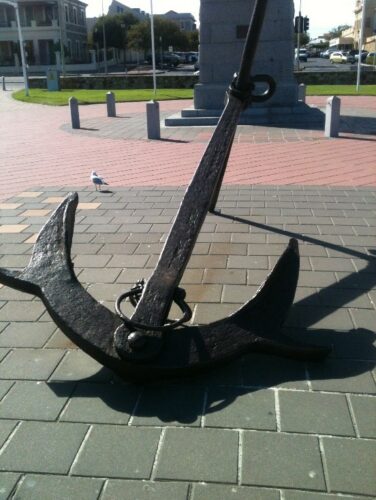
A Trotman anchor
Nick Reed from the Big Anchor Project said that the Trotman anchor came into common use around 1850. He says that this anchor was an attempt to solve the issue of storing anchors. It also solved the issue of a fluke and arm sticking up when it a ship was at anchor. This concept lead to the stockless anchor. A stockless anchor is more streamlined than a stocked anchor, making it easier to handle and stow. It was developed to allow for stowing in the hawse pipe of a ship and it continues to be used to this day.
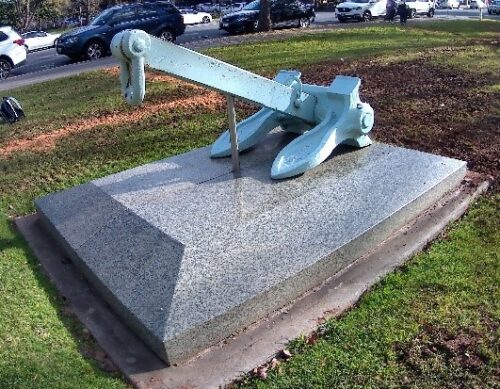
A stockless anchor

In 1887, WL Byers patented a stockless anchor where the inner surface of the flukes was made concave to improve holding power. The Royal Navy’s last conventional aircraft carrier, HMS Ark Royal, carried Byers’ stockless anchors up until 1980.

Byers were a ubiquitous make until the advent of cheap anchors from the far east during the latter half of the 20th century. Prior to WWII, they often had a swastika on them. This was taken from the Sanskrit symbol of good luck rather than any association with the Nazis. This feature often leads them to be misidentified as WWII German.
The Baldt stockless anchor (from Chester, Pennsylvania) is said to have played a major role in the American war effort as well as in the oil & gas sector in later years.)

Baldt
Richard Danforth designed the Danforth anchor in 1939. The anchor was widely used for anchoring aircrafts, bridges and boats during World War II. Two large flat triangular flukes are attached to a stock at the crown. If buried well, the anchor can develop high resistance and is also easy to retrieve.

Danforth anchor
It has been suggested that the size and style of an anchor may indicate the type of vessel that it was originally used on. With this in mind, I thought that I would be able to estimate the kind and size of vessel that many of the Port Adelaide anchors came from. Further research, however, revealed the following: –
In 1981, Mike McCarthy, then Assistant Curator for the WA Maritime Museum (and in charge of wreck inspection for the Department of Maritime Archaeology) wrote in a letter that “An estimate of the vessel’s size from the anchor can be misleading due to each individual vessel carrying 3 or more anchors on board, all in some cases, of quite different size.” 8
In 1982, Mike also wrote, “Using anchor size as an indication of tonnage is also fraught with problems unless the whole range of anchors on board is available for analysis.” 9
In 1981, NE Upham, Deputy Head of the Department of Ships at the National Museum, London, wrote about a particular anchor, saying “it would appear to be the bower anchor of a brig or small barquentine, or it could be the stream anchor of a larger vessel. This is a secondary anchor used in working a vessel up or down a river. It was similar to the bower anchor but smaller.” 10
Thinking about the number of anchors usually carried by a large ship, and the size of those anchors, despite the above statements, let us consider the 1912-built, 269m-long ship Titanic. There were five anchors, the ones on the port and starboard side, the large anchor on her bow and two kedge anchors, (located on the forecastle on the starboard side just behind the breakwater and one located on the poop deck). The two side anchors are said to have weighed 7.87 tonne (7.75 ton) each. The centre anchor is said to have weighed 15.75 tonne (15.5 ton). The cables used in connection with the side anchors are said to have weighed 97.5 tonne (96 ton). Most vessels, however, are much smaller than the Titanic, and their anchors are also much smaller.
For comparison, according to “Shipwrecks along the Southern Coast” by GA Nayler11, three anchors were recovered from the three-masted 1026-tonne (1010-ton) wooden ship Joseph H Scammell wrecked at Torquay, Victoria in May 1891. The largest anchor weighed 2 tonne/ton, the second largest was 0.75 tonne/ton and the smallest was approximately 300kgs (6 cwt*). These anchors were recovered by members of the Geelong Skindivers’ Club from 1970 to 1971.
* (cwt = hundredweight. According to Wikipedia, “The hundredweight (abbreviation: cwt), formerly also known as the centum weight or quintal, is an English, imperial, and US customary unit of weight or mass of various values. Its value differs between the American and imperial systems. The two values are distinguished in American English as the “short” and “long” hundredweight and in British English as the “cental” and the “imperial hundredweight”.” Taking this a step further:
BRITISH – a unit of weight equal to 112 lb avoirdupois (about 50.8 kg)
US – a unit of weight equal to 100 lb (about 45.4 kg)
OTHER – a unit of weight equal to 50 kg)
According to “Whale of a Shark” by Ben Cropp12, there were at least four large anchors on the 1342-tonne (1321-ton) sailing ship Dunbar that was wrecked in 1857. These anchors are said to be 3.66m (12’) long and have flukes 1.829m (6’) across. The wreck of the 894-tonne (880-ton) clipper Catherine Adamson had three large anchors. The 1803 wreck HMS Porpoise also had three large anchors. These were described as being “British Admiralty Old Plan wooden stock anchors manufactured around 1800 or a little earlier”. They are each 3.66m (12’) long and just over 1 tonne/ton.
The Porpoise was formerly the Spanish vessel Infanta Amelia. According to Wikipedia13, HMS Porpoise was a 12-gun, 308-tonne, 28.35m-long sloop built in Bilbao, Spain in 1799. It was captured by HMS Argo off the coast of Portugal that same year.
The “Loch Vennachar expedition report” by the Society for Underwater Historical Research (SUHR)14 says that the 76m-long (250’), 1552-ton clipper Loch Vennachar had as many as seven anchors, ranging in size from 1.22m (4’) long & weighing ¾ tonne/ton to 3.66m (12’) long with 1.37m (4’6”) long flukes & weighing an estimated 5 tonne (4-5 ton). Several of the anchors were said to be ‘pivoting anchors’, with the two biggest ones (bower anchors?) being 3.5m long and weighing an estimated 3-5 tonne. The Loch Vennachar was built in Glasgow, Scotland in 1875. It was wrecked near West Bay, Kangaroo Island in 1905. The SUHR found the wreck in 1976.
Much of the above suggests that without the context of having all anchors from a ship, it is difficult to back calculate the size of a ship from an anchor. This would certainly be the case in regard to the anchors around Port Adelaide.
FURTHER DISCUSSION ON ANCHOR DESIGN
According to “Anchor Terminology used in Shipping at https://cultofsea.com/deck-work/anchor-terminology-used-in-shipping/15, “A “stock” is a horizontal arm which is set at right angles to the arms and flukes of the lower part of the anchor. The stock ensures that the arms rest vertically on the seabed, and thus one fluke will dig itself in, providing maximum holding power.

A stock anchor
This was called the Stock Anchor and has remained the basic anchor for many centuries.”
The Old Admiralty longshank anchor was designed by the Royal Navy and it was used throughout the 1700s.
The Admiralty Pattern stocked anchor is a reinvention of a classical design, as seen in one of the Lake Nemi ship anchors*. This basic design remained unchanged for centuries, with the most significant changes being to the overall proportions, and a move from stocks made of wood to iron stocks in the late 1830s and early 1840s.
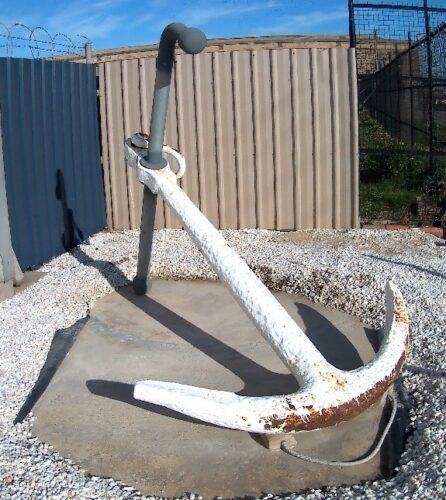
‘Admiralty pattern’ anchor
* (According to “Caligula’s Nemi Ships” at https://abc.se/~pa/mar/nemships.htm16 , the two Lake Nemi ships “had possibly been used as ceremonial ships in the Egyptian Isis cult around 37-41 AD, favoured by emperor Caligula, but nobody knows. …… The Lake Nemi ships were two outsize pleasure barges built on the orders of the Roman emperor Caligula. They were not intended for use on the sea, but were built to use on the lake. Even so, they are built to the highest degree possible for Roman shipwrights. The barges were 70m (200 ft) long and 18m (60 ft) wide. They were built using the efficient mortise and tenon fastenings, with copper nails and lead sheathing along the hull. The barges were filled with marble and statues. The main interest in the Lake Nemi ships is that they prove that the Romans were capable of building huge ships, as the grain carriers were reputed to be. Before the excavation of these barges, scholars had often ridiculed the idea that the Romans had that degree of sophistication needed to build a truly large ship. Among the things found with the boats were lead stocked anchors. Roman ships carried a quantity of these, but at the time of the Lake Nemi ships they were slowly being replaced by the iron anchors in the 2nd century AD. Lead stocked anchors, although efficient, due to being half of wood could rot, while iron anchors survived for longer.)

‘Admiralty pattern’ anchor
The Admiralty Pattern anchor is sometimes referred to simply as “Admiralty”. It is also known as a “Fisherman”.
Wikipedia describes the Admiralty Pattern anchor thus – “consists of a central shank with a ring or shackle for attaching the rode*. At the other end of the shank there are two arms, carrying the flukes, while the stock is mounted to the shackle end, at ninety degrees to the arms. When the anchor lands on the bottom, it will generally fall over with the arms parallel to the seabed. As a strain comes onto the rode*, the stock will dig into the bottom, canting the anchor until one of the flukes catches and digs into the bottom.
* (rode: [noun] a line (as of rope or chain) used to attach an anchor to a boat.)
“Since one fluke always protrudes up from the set anchor, there is a great tendency of the rode to foul the anchor as the vessel swings due to wind or current shifts. When this happens, the anchor may be pulled out of the bottom, and in some cases may need to be hauled up to be re-set. In the mid-19th century, numerous modifications were attempted to alleviate these problems, as well as improve holding power, including one-armed mooring anchors. The most successful of these patent anchors, the Trotman Anchor*, introduced a pivot where the arms join the shank, allowing the “idle” arm to fold against the shank.”
* (See further below)

Trotman anchor
“Handling and storage of these anchors requires special equipment and procedures. Once the anchor is hauled up to the hawsepipe, the ring end is hoisted up to the end of a timber projecting from the bow known as the cathead. The crown of the anchor is then hauled up with a heavy tackle until one fluke can be hooked over the rail. This is known as “catting and fishing” the anchor. Before dropping the anchor, the fishing process is reversed, and the anchor is dropped from the end of the cathead.”
The ‘Old Admiralty Longshank Anchor’ was designed by the Royal Navy. It was used throughout the 1700s, but these often required repairs and suffered breakages. This was often due to the fact that they were so straight. In 1813, therefore, Richard Pering, one of Britain’s leading designers at the time, introduced and patented the long shank stocked anchor with the shanks and flukes shorter and smaller than the Old Admiralty Longshank Anchor. The new version was approved and adopted by the Royal Navy and further improvement and more curved arms took place in 1830. Another key designer of the 1800s was Lieutenant William Rodger, best known for the Small-Palmed Anchor.
The iron-stocked Admiralty anchor was introduced by Admiral Sir William Parker in 1841. This anchor was made from wrought iron, with a wooden or iron stock. An iron stock was mainly used for iron and steel-hulled ships. This anchor had a great holding power. It was used on large ships for anchoring offshore. The long stock could cause problems with the anchor chain sometimes, or it could also pierce the hull of the ship.
The Trotman anchor was patented in 1852 by John Trotman. He introduced a pivot where the anchor’s arms join the shank, allowing the “idle” arm to fold against the shank. It is the most successful of patent anchors. It is sometimes referred to as a ‘pivoting’ or ‘swing’ anchor.
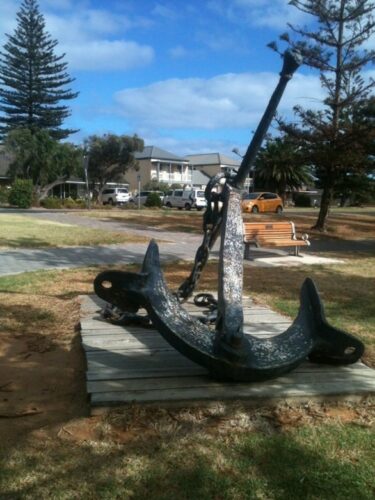
Trotman anchor
With its mobile arms, Trotman’s anchor was difficult to handle or stow. Although it was used by merchant ships, it was not favoured by the Navy. It was redesigned by William Porter who patented a hinged-arm anchor in England in 1838.
Anchor Terminology used in Shipping at https://cultofsea.com/deck-work/anchor-terminology-used-in-shipping/15 also explains that the stock anchor was eventually “replaced by the modern day “Stockless Anchor” ….. (patented in England in 1821) …. widely used principally because of its ease of handling and stowing. The flukes are long and heavy and have projecting shoulders at their base that catch on the seabed. As more drag is exerted, the shoulders force the flukes downward into the bottom. Stockless anchors have replaced the older stock anchor on most of the large ships of the world.”
The stockless anchor is described by Wikipedia as “the first significant departure in anchor design in centuries. Though their holding-power-to-weight ratio is significantly lower than admiralty pattern anchors, their ease of handling and stowage aboard large ships led to almost universal adoption. In contrast to the elaborate stowage procedures for earlier anchors, stockless anchors are simply hauled up until they rest with the shank inside the hawsepipes, and the flukes against the hull (or inside a recess in the hull). Whilst there are numerous variations, stockless anchors consist of a set of heavy flukes connected by a pivot or ball and socket joint to a shank. Cast into the crown of the anchor is a set of tripping palms, projections that drag on the bottom, forcing the main flukes to dig in.”
ANCHOR MATERIAL AND TESTING
ANCHOR MATERIAL
According to the web page found at https://dieselship.com/marine-technical-articles/ship-safety-and-naval-architecture/ship-anchor-complete-information/ 17, modern anchors for large ships are made of cast steel, making them tough and shock loading and breakage resistant, especially for when anchors strike hard rocky surfaces whilst anchoring.
ANCHOR TESTING
Also, according to the same web page, older anchors were made of cast iron and they were tested by dropping them on hard ground from a height of about 22.86 metres (75 feet). Only anchors that successfully survived this drop test were sent to their ship. Later drop tests involved dropping anchors from 4.6 metres (15 feet) “onto a steel slab laid out on a concrete foundation”. The newer cast steel anchors are hydraulically pressure tested on chain testing machines.
According to the web page found at https://www.shipsnostalgia.com/showthread.php?t=10762518, it was a legal requirement to test all British stockless anchors manufactured between 1864 & 1967 of above 76.2 kg (168 pounds) weight (designed for merchant ships). Anchors were weighed in hundredweights (cwt), quarters (qtrs) & pounds (lbs) up until metric. The old drop test would have been used on the cast iron anchors, whilst the pressure test would have been used on the cast steel anchors.
In the case of drop testing:
The left fluke has a diamond within which shape is (in sequence):
- a) the mark of the assigning authority (e.g. Lloyd’s),
- b) the weight of the head,
- c) the surveyor’s initials,
- d) the number of the ‘drop test’ certificate
- e) the date of the ‘drop test’.
The right fluke will have a circle – & within that circle is:
- f) the proving house identification mark,
- g) the number of the test certificate,
- h) the number of the tensile test machine,
- i) the year of licence of the machine,
- j) the applied proof strain & the government mark.
The shank of the anchor would have the same markings as on the right fluke & also, near the shackle, would record the total weight of the anchor.
Anchor Terminology used in Shipping
According to “Anchor Terminology used in Shipping” at https://cultofsea.com/deck-work/anchor-terminology-used-in-shipping/ 15, some of the anchor terminology used in shipping includes:
Anchor aweigh: The anchor is said to be aweigh immediately it is clear of the bottom.
Anchor dragging: The anchor is said to be dragging when it is not held seabed.
Foul anchor: Used to describe an anchor which is caught in an underwater cable, or which has brought old hawsers to the surface with it, or which is fouled by its own cable.
Weighing anchor: Weighing anchor is the operation of heaving in cable until the anchor is broken out of the bottom.
There are many other terms listed there.
THE ANCHORS TO BE FOUND ON LAND AROUND PORT ADELAIDE AND THE LEFEVRE PENINSULA
Following below are what we have been able to find out regarding the numerous anchors to be found on land around Port Adelaide and the Lefevre Peninsula: –
Anchor locations in alphabetical order
Birkenhead Riverview Tavern, Riverview St, Birkenhead – 2 large anchors. These are located either side of the river side of the Birkenhead Tavern, which first opened in 1878. There is both a stocked anchor and a stockless anchor (adjacent to a large propeller) there.

The stocked anchor is over 3.4m long. It has a 3.1m-long stock and the total width of the arms is over 2.3m. This anchor is probably the most common style of anchor on display around the world. It is an Admiralty Pattern anchor with a folding stock (designed to be folded when not in use so that anchor can be stored on deck). It came into common use during the mid to late 1800s. These were often stored on a vessel as a back-up anchor. Nick Reed from the Big Anchor Project described this anchor as having a faceted shank and added that it seems to be cast rather than hammer-welded, suggesting that it is from the early to mid-20th century.

The stockless anchor is 2.5m long, with a 1.4m base and the total width of the arms being 1.4m. It is located adjacent to a large propeller. Nick Reed from the Big Anchor Project described it as a standard stockless anchor, which was first patented in the early 1800s (Hawkins 1821) and became the standard anchor for most larger vessels. Nick said that this particular anchor could be a “Union” or “Hall’s” style anchor, estimated to be from the mid-20th century.


Both anchors were donated by the late Keith Le Leu, OAM (a local Port Adelaide identity who died in 2006) between 1992 and 1994. Both anchors were erected at Birkenhead by the City of Port Adelaide in August 1995. Plaques at each anchor give details of the commemorations that the anchors each mark.


The Hall’s stockless anchor, with the head of the anchor held by a pin through it, was introduced in 1886. Further patents and innovations to the anchor took place (as well as approval by Lloyds in 1923), with the anchor becoming one of the most popular anchors of the period.
Largs Bay (3)
Largs Bay Jetty, Esplanade/Lady Gowrie Drive, Largs Bay – 1 large (mooring?) anchor 2.5m long & wide (opposite the Largs Pier Hotel, and immediately south of the Largs Bay Kiosk by the jetty).

The large, stocked anchor sits at the base of a cairn commemorating the centenary of Largs (Bay). The cairn was erected by the Rotary Club of Largs Bay and unveiled by HCR (Roy) Marten, the Mayor of Port Adelaide on 1st January 1983. It has been described as a Standard Admiralty pattern anchor, which are common throughout the UK and likely to be from the late 19th century. Nick Reed from the Big Anchor Project said that this one has been used as a mooring anchor because the “top” arm has been bent over. This would have prevented the hull being damaged by the upward facing arm if the tide dropped too much. The arm is said to show evidence of a break. It is unclear whether this was why it was used as a mooring anchor, or if it was broken when it was bent over.
Largs Bay RSL, 17 Carnarvon Tce, Largs Bay – 2 stockless anchors over 1m high.

One anchor is located at the front of building and another anchor is located at the right-hand side of the building. Nick Reed from the Big Anchor Project described these two anchors as “Typical small stockless anchors, most likely a Union type. Details on the arms often give weights, etc..” These two anchors are both stamped 150 kgs (3 cwt?).
(There used to be a third anchor at this location. It was exchanged for a propeller from the Edinburgh Air Base. The anchor is now located in a mess hall at the base.)
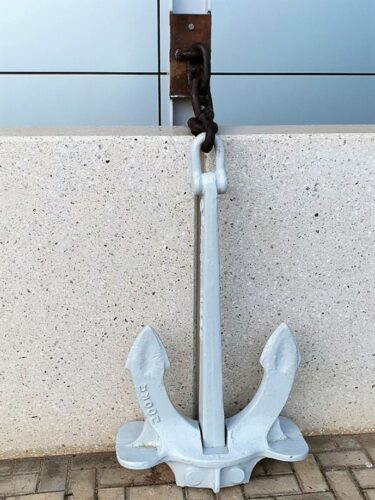
New Port (1)
Entrance to the Naval Reserve Cadets, Jenkins Street, New Port (formerly Birkenhead) – 1 stocked anchor.

This anchor has a shaft over 2.35m long, a (new) stock of around 2m and arms that have a total width of 1.6m. Nick Reed from the Big Anchor Project described it as a Standard Admiralty pattern anchor with a removeable stock. The flukes of the anchor seem to have either been removed or have been damaged. It is estimated to have most likely been a 20th Century anchor. It may well have been “folded” up and carried as a spare anchor. It was placed at this site in May 2019 to replace the large artillery gun now adjacent to Semaphore jetty. The plaque at the anchor was originally placed with the gun at the entrance to the Naval Reserve Cadets.
North Haven (1)
North Haven Marine, Shop 1, 23 Alexa Rd, North Haven – 1 (Admiralty Pattern) stocked anchor
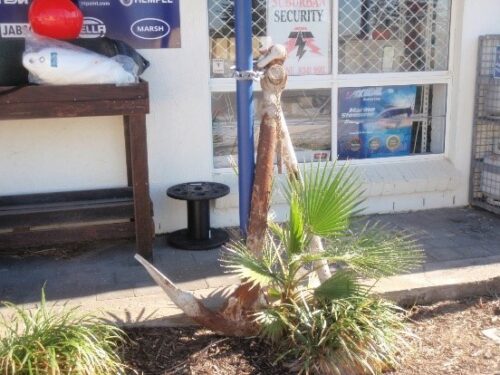
This stocked anchor is 1.36m long and the arms have a total width of 1.09m. It is located out the front of the shop. It is said to have come from the fireboat on the Port River. The 20m-long fireboat (Emergency Response Vessel) ERV Gallantry was officially launched on 14th April 1994. It is operated by the SA Metropolitan Fire Service. It is due to be replaced in 2024 because it has a 30-year replacement program.
Enter the North Haven Marine shop to view many modern-type anchors, including ‘Marsh’ anchors like this one: –

North Haven Marine specialize in the sale of ‘Marsh’ anchors. These are available in a range of sizes. They are said to be ideal for use in the weedy and sandy substrates of Gulf St Vincent. They are made in South Australia by Industrial Engineers & Spring Makers (Sales) Pty Ltd (at Hindmarsh, possibly the reason for them being called ‘Marsh’ anchors. Further details can be found on the North Haven Marine website at www.nhmarine.com.au .
Port Adelaide (4)
Adelaide Dockside Self Storage, Port River Expressway (east side of the Diver Derrick Bridge. Access via Wauwa St.) – 1 stockless anchor

This anchor is 1.7m long and arms that have a total width of 1m. It came from the 800-tonne barge Bradley, the barge supporting the City of Adelaide clipper ship at the time of writing. The anchors currently on the barge are 2.1m long. Nick Reed from the Big Anchor Project described this anchor as a standard mid to late 20th century stockless anchor. Nick said that the shape of the flukes (distinctive spade shape), raised ridge on the arm and flat “weight” at the bottom would suggest possibly a “Spek” style anchor.

Naval Association of Australia, 35 Quebec St, Port Adelaide (adjacent Port Mall Shopping Centre) – 1 stockless anchor 1.2m long (+ a flagstaff featuring an anchor inside the centre).

The stockless anchor outside has a weight of 1.2 tonne (4 cwt). Nick Reed from the Big Anchor Project said that this anchor looks like it is a “Byers” clone (manufacturers would adapt this design for ease of manufacturing).

Nick Reed estimated it as being from the mid to late 20th century. It was unveiled by Mr Rod Sawford, the Federal Member for Port Adelaide, on 15th August 2005 to commemorate the 60th anniversary of V.P. Day (Victory in the Pacific Day, or Victory over Japan Day). This anchor was donated by the family of A.B. W.H.(Harry) Cadd, ex HMAS Norman. HMAS Norman was a RAN N-class destroyer on loan from the Royal Navy during World War II.
North Parade, at the edge of the small car park on the corner of Robe St and Nile St. – 1 large, stocked anchor.

The stock is some 3.5m long, the shaft around 3.3m long and the arms have a total width of 2m. Nick Reed from the Big Anchor Project said that this anchor is a Rodger’s small palm anchor (after Lieut. William Rodger RN). ‘Small palm’ because the flukes, or the “palms” almost look delicate compared to the anchor. Although it is possibly from the mid-1850s, the chain attached to the anchor is stamped “1916”. This anchor is believed to be the mooring anchor for the old steamship mooring buoy at Largs Bay, where passengers were ferried ashore by small boats prior to the Outer Harbor being developed. Nick Reed said that this anchor has an “Interesting squared shank. Straight stock fastened by a cotter pin. Stock could be removed to aid stowage.” Nick Reed described the Rodger’s small palm anchor as “Well thought of and designed to give better grip.”
(At the time of writing, the Port Adelaide Enfield Council is considering relocating the anchor, although they do not expect this to happen for a year or two.)
Quin Marine, 331 St Vincent Street East, Port Adelaide – 1 large, stocked anchor

This anchor is 3.3m long, has a stock that is also 3.3m long, and arms that have a total width of 2.4m. Nick Reed from the Big Anchor Project described it as “20th Century stocked anchor – admiralty pattern. Distinct tip to palms / flukes known as a bill. Ring at the end of the crown for attaching a buoy to assist with tripping of the anchor. Sometimes known as a fishbuckle or tripping ring.”
A fishbuckle was fitted to an anchor to assist in stowing.
This anchor was treated and painted during 2019 in readiness for relocation at the front gate to the Quin Marine premises.
It has been suggested by the owners of North Haven Marine that this anchor had previously been located at North Haven before being moved to Quin’s old premises further west on St Vincent Street (adjacent to the Jervois bridge). Stan Quin, however, believes that the anchor was purchased from a dredging company.
Royal Park* (1)
Old Port Road – middle of the junction of Old Port Rd, Webb Street & Frederick Rd,
(* Royal Park, Queenstown, West Lakes or Port Adelaide) – 1 large, stocked anchor over 3m long.

This anchor is maintained by the City of Charles Sturt. It was placed there by the then Woodville Council as part of South Australia’s Jubilee celebrations in November 1986. It was placed there adjacent to an earlier perma-pine structure representing HMS Rapid to commemorate Colonel William Light’s journey up the Port River. The purpose of the anchor was to enhance the replica Rapid rather than having any historical significance. The anchor is said to have been obtained from a shipping junk yard or similar. It has previously been partially hidden by foliage, but the City of Charles Sturt council recently cut the foliage back upon the author’s request. It has been described as “Admiralty pattern anchor with shackle rather than ring. It is suspected to be from the 20th century and looks like it has a squared shank with straight stock.”
At Dan Monceaux’s suggestion, I returned to the large anchor in October 2020 to dig around the half-buried visible fluke. I was only able to reveal about 2/3rds of the fluke and arm: –
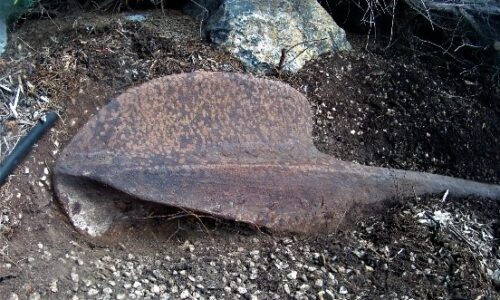
I then tried to dig around the opposite arm, which turned out to be non-existent. I then dug around the crown of the anchor, revealing this welded-on rod: –

I could see by the crown that the missing arm had been removed: –

I took a few photos of the fluke, arm, crown, etc… and posted them on the Big Anchor Project Facebook page for comment.
Nick Reed commented, “That looks more like one (a Rodger’s small palm anchor), has that bit of a curve back where the fluke joins the crown,”.
Dan Monceaux agreed, “Rodger’s small palm, judging by the fluke on the existing arm,”.
Peter Holt commented on the Facebook page that the anchor, having one arm only, is (was) a mooring anchor. “The loop on the bottom may be to attach a tripping line used to pull it up when the anchor needs to be moved,” he said.
As explained earlier, mooring anchors in shallow water would either have one fluke only, or have one of its two flukes bent over (like the one seen at the Largs Bay jetty), to save a vessel from sitting on the fluke of its own anchor. Larger flukes were sometimes added for use in soft, muddy bottoms.
Semaphore (2)
Semaphore Jetty, Esplanade, Semaphore (between the clock tower memorial and the large artillery gun adjacent to the jetty) – 1 large, stocked anchor from the Star of Greece shipwreck.
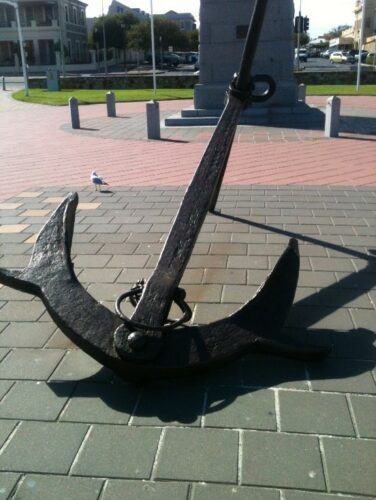
This anchor is 3.36m long, has a stock over 2.5m long and arms that have a total width of 1.8m. It is a Trotman’s anchor from the 1888 wreck of Star of Greece at Port Willunga. “Star of Greece: For Profit and Glory” by Paul W. Simpson states that the 1868-built, three-masted steel ship Star of Greece carried two Trotman’s anchors and two Admiralty Patent anchors.
This anchor is part of the “Sea Captains’ Memorial” built by the Port Adelaide Council and unveiled by the Port Adelaide Mayor, HJ Moore in April 1952. It was originally located just north of the Semaphore jetty, just before the Palais. It was said to be “10 ft. 6 in. long and weigh between 25 and 30 cwt” at the time.

Re. the “Sea Captains’ Memorial”, Vernon Smith* compiled “Brief Biographical Notes of the Lives of Some of Those Sailing Ship Captains of the Semaphore (Retired) Whose Names Are Recorded on the Memorial Erected on the Foreshore North of the Semaphore Jetty” (which it was at the time). A reference copy is available in the Port Adelaide Library – Ref: LH 387.204 09423 SMI. * (Smith was curator for the Port Adelaide Institute’s Nautical Museum in the 1960s, a position that he held over a period of fifty years. He died in 1975, aged 100.)
Le Fevre High School, 90 Hart Street, Semaphore South (corner of Hart St & Swan Tce) – 1 large, stocked anchor donated by Keith Le Leu.

It is 1.5m long and arms that have a total width of 1m. The stock has been bent out of shape. Nick Reed from the Big Anchor Project said that this is an Admiralty pattern anchor, and that it looks like a ‘Rodger’s small palm’ due to the small spade-shaped fluke (or palm). Nick said that this would date the anchor from the 1850s onward. Nick Reed described the shank as ‘squared’ and looking like it has been hammer-welded, supporting dating as from the 1850s onwards.
West Lakes (1)
Frome Reserve, Frome Crescent, West Lakes -1 large, stocked anchor (adjacent children’s playground).
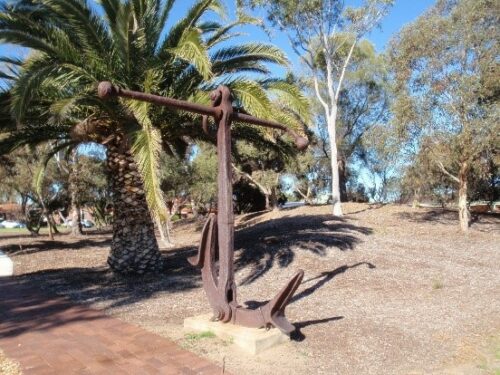
This anchor is maintained by the City of Charles Sturt. It is thought to be a bower anchor, one of the two main anchors of a ship. These are carried on each side of the ship’s bow and permanently attached to their cables. These anchors are always ready to be let go in case of an emergency. This particular anchor is a Trotman’s anchor about 2.7m long. It was placed there in 1972. Nick Reed from the Big Anchor Project said that this anchor is from “around mid to late 19th century (came into common use around 1850). (This) Was an attempt to solve the issue of storing the anchor. Hinged at the crown. Also solved the issue of fluke and arm sticking up when it was at anchor. Concept lead to the stockless anchor.”
Wingfield (1)
Adjacent to the Education Centre within the Wingfield Dump
A Danforth* anchor (with crown stock) – shank 3.15m long, stock 2.577m wide, ‘5000 lbs’.
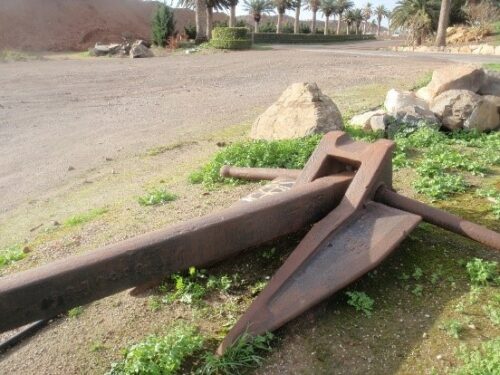
* (Designed by Richard Danforth in 1939. The anchor was widely during World War II for anchoring aircrafts, bridges and boats. Two large flat triangular flukes are attached to a stock at the crown. If buried well, the anchor can develop high resistance and is also easy to retrieve.)
Replica Anchors
Outer Harbor (1)
SA Trailer Boat Club Inc., Bourne-Jones Rd, Outer Harbor (Off of Victoria Rd & Oliver Rogers Rd).

It is located between the Royal South Australian Yacht Squadron & the Scouts (SA) Water Training Centre. This is only a replica (home-made) anchor made and donated by Max Peterson in January 1994. Nick Reed from the Big Anchor Project described it as “Admiralty pattern anchor but, looking at the size and construction, (it) looks like what we would refer to as a fisherman’s anchor. It looks like it should be 20th century, probably later half. Interesting way in which the crown is attached to the shank.”
Port Adelaide (2)
Navigator Memorial, Timpson Place, Port Adelaide – 1 replica anchor (up high on side of building)
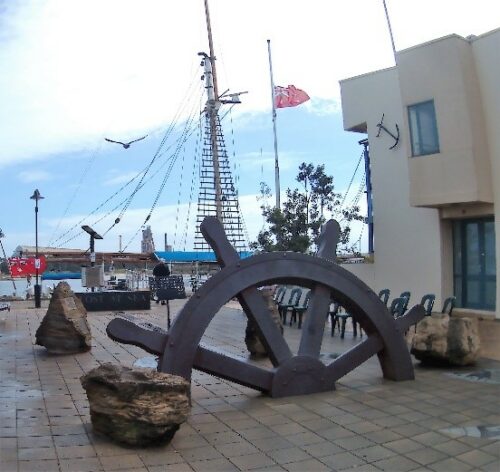
Port Anchor Hotel, 15 Church St, Port Adelaide – 1 replica anchor (inside the hotel as part of the hotel’s many promotional signs).

The hotel was first opened in 1876 as the Kent Hotel. See http://portanchorhotel.com.au/ . Nick Reed from the Big Anchor Project described this anchor as another “fisherman’s anchor of similar construction to the Outer Harbor one. Its stock is in the wrong plane for functionality and would suggest that it is (purely) decorative. Flukes also look as if they would be too weak to be functional.”
Semaphore (1)
Semaphore water slide, between the Semaphore jetty and the Semaphore Palais – 1 replica anchor adjacent to the wrought iron fence facing the beach.
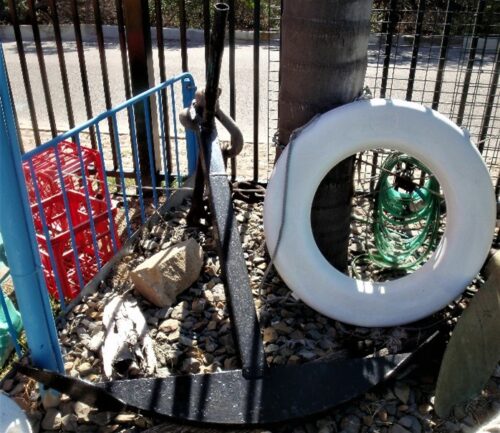
‘On-Water’ Anchors at Port Adelaide
Further anchors can be seen either on water or inside museums, as detailed below: –
Several vessels berthed along Queen’s Wharf, between the Birkenhead Bridge on Nelson St. and No.1 Dock on Ocean Steamers Rd, bear anchors that can be seen from the wharf. These ‘ships’ include the Dolphin Explorer, the steam tug Yelta, the sailing ship Falie, the tall ship One and All and several recreational pleasure boats.

The Yelta carries a spare anchor inside her bow.

The flukes on the auxiliary ketch Falie’s anchor have been said to have a distinctive diamond on them, and there is also a raised rim around the edge of the arms and flukes, suggesting that it is a “Byers” anchor. Supporters of the Falie celebrated its centenary in 2019. The vessel was built in the Netherlands 1919.

The anchor on the tall ship One and All has been described by Nick Reed from the Big Anchor Project as looking “like a Hall or Union stockless anchor. Certainly, 20th century….
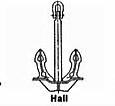

This anchor shows how a stockless anchor would slide up into the hawse pipes for stowage.”
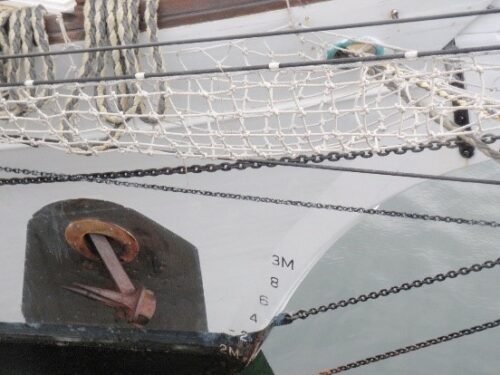
The Falie and the One and All are both moored at the wharf most, if not all, of the time and they allow visitors onboard at times.
There are two large anchors hanging from the 800-tonne barge Bradley holding the clipper ship City of Adelaide whilst it is moored in Dock 2 awaiting a more permanent location. These anchors are 2.1m long and arms that have a total width of 1.4m.
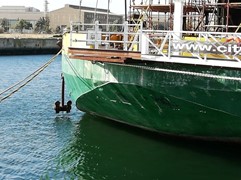
The flukes of the anchor on the barge Bradley are rounded, suggesting that the anchor is either a Byers or a Baldt-style stockless anchor. probably mid to late 20th century.


Baldt
As already mentioned above, the anchor at Adelaide Dockside Self Storage, Port River Expressway (east side of the Diver Derrick Bridge came from the 800-tonne barge Bradley, the barge currently supporting the City of Adelaide clipper ship.)
The 1883-built ‘tug’ Nelcebee, dry-docked at Dock 2, carries a stockless anchor which can be seen when visiting the area. Nick Reed from the Big Anchor Project said that its shape indicates that it is a KLIP anchor, but that the fluke shape seems to indicate a variation.

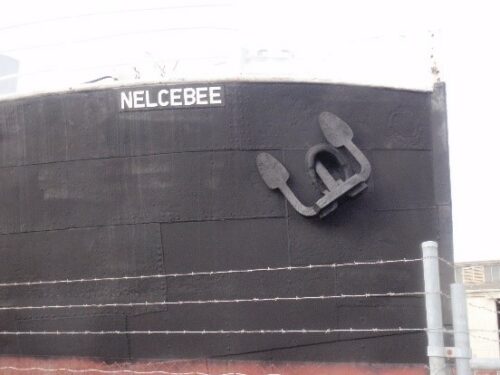
More vessels with anchors can be found further west, past the Birkenhead Bridge, at the site of the Australian Maritime & Fisheries Academy, 20 North Parade, Port Adelaide. More vessels may be viewed at various locations north along the river. Some ships’ berths may be accessible, and some may not be. Large ships also berth at Outer Harbor (correct spelling), but it will be difficult to get close to these vessels. There is, however, a small fishing landing adjacent to the Pilot Station at the end of both Lady Ruthven Drive and Oliver Rogers Road that may assist a little.
Even more vessels with anchors can be found at the Torrens Island Market located at the end of Moorhouse Road (near the end of the Grand Trunkway), Port Adelaide, but access to the vessels is via a normally locked gate to the two pontoons at the wharf.


(The old tug Fearless located on land between the Birkenhead Tavern and the Birkenhead Bridge still carries two anchors on its bow, but these cannot be seen up close due to fencing around the vessel at present. Nick Reed from the Big Anchor Project described one of the anchors as “Stockless anchor, hard to tell the make but it looks like a Union type. Boat looks like it is late 20th century so that would date anchor.” Mr. Keith Le Leu had bought the Canadian-built tug Fearless in Brisbane in 1972 and it was eventually land-locked at Birkenhead.)
ANCHORS WHICH CAN BE SEEN INSIDE MUSEUMS
South Australian Maritime Museum, 126 Lipson St, Port Adelaide
Two anchors can be seen inside the South Australian Maritime Museum (entry charges apply). One is a 4m-long, 1 tonne stocked anchor from Matthew Flinders’ ship HMS Investigator. The other one is the anchor on the bow of the replica ketch Active II (both inside the Museum). Nick Reed from the Big Anchor Project described this anchor as “Admiralty pattern, shows hammer welding & round crown (probably putting it late half of 19th century). The anchor shows how stocked anchors would be stored. The anchor is “catted”. The white beam sticking out ahead of them anchor is known as a cathead.”
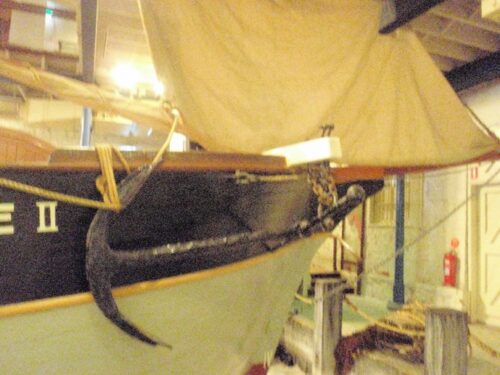
The Investigator’s anchor is possibly the oldest known anchor in South Australia. It has a (replica) large wooden stock. It seems to be a straight-armed anchor A change from curved stocked anchors to straight-armed ones is thought to have taken place in English vessels between 1540 and 1600. The straight-armed anchor was easier to manufacture in large dimensions as ships required larger and larger anchors. This anchor from HMS Investigator is a ‘best bower anchor’. A bower anchor is each of two anchors carried at a ship’s bow. The best bower anchor is the starboard bower anchor, whilst the port bow anchor is called the small bower anchor.

This particular anchor is the largest of two anchors that were cut loose by Matthew Flinders during rising winds in 1803. These were located in Goose Island Bay on 14th January 1973 by members of the Underwater Explorers Club of SA. The anchors were both raised up by the lighthouse ship Cape Don on 19th January 1973.
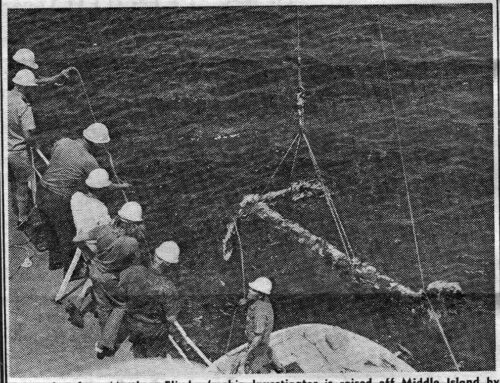
Video footage in the museum shows the two anchors being recovered. They have now been preserved and restored. The smaller anchor, a 3m-long, 406kg stream anchor, was placed in Canberra along with an anchor from James Cook’s Endeavour.
Austbuilt Museum, 95 Fletcher Road, Peterhead
Two anchors can also be seen at the Austbuilt Museum. There are two stocked anchors – 1 large, 1 small. Both can be seen just inside the Museum’s front gate & fence.


Details of the two anchors are unknown. The museum, which was commenced by Mr. Keith Le Leu in 1962, houses a collection of shipping artifacts and memorabilia. Mr. Le Leu donated his museum to the Port Adelaide Historical Society in 2004. The museum is open from 2 – 4pm each Sunday. An admission fee applies to enter the museum. Contact the Society’s Secretary at secretary@porthistory.net or the museum direct at museum@porthistory.net .
I continue to find ‘new’ anchors around the state, or information about ones already known. I must make mention of the fact that land-based anchors have a bit of a habit of moving location from time to time. Many of the anchors discussed above, and others, have been relocated at some stage. The Star of Greece anchor at Semaphore, the anchor at Quin Marine, Port Adelaide, the anchor at North Parade, Port Adelaide, and one of the three anchors originally at the Largs Bay RSL are all examples of anchors known to have been relocated. Some of them are expected to be relocated (again?) in the near future.
BIBLIOGRAPHY
(Provided by Nick Reed from the Big Anchor Project)
“Anchors – An Illustrated History” by Betty Nelson Curryer (1999)
“A Treatise on the Anchor” by Richard Pering (1819)
“Explanatory Observations” by William Rodger (1852)
“A Treatise on Ships’ Anchors” by George Cotsell (1856)
“The History and Development of English Anchors CA. 1550 to 1850 – A thesis by Harold Jobling” (1993)
“Ancient Anchors – technology and classification” by Gerhard Kapitan, the International Journal of Nautical Archaeology and Underwater Exploration (1984), 13.1: 33-44
(Provided by Greg Votruba)
Wilson, A. I., ‘Developments in Mediterranean Shipping and Maritime Trade from the Hellenistic Period to a.d. 1000’, in D. Robinson and A. Wilson (eds), Maritime Archaeology and Ancient Trade in the Mediterranean, Oxford Centre for Maritime Archaeology Monograph 6 (Oxford, 2011), 33–59
Votruba, G. F. 2014, Iron Anchors and Mooring in the Ancient Mediterranean (until ca. 1500 CE), unpublished D.Phil thesis, University of Oxford.
Votruba, G. F. & Erkurt, O., 2017, The World Anchors Reconstruction and Experimentation Project (WAREP): an introduction, in J. Gawronski, A. van Holk & J. Schokkenbroek (eds), Ships and Maritime Landscapes: Proceedings of the Thirteenth International Symposium on Boat and Ship Archaeology, Amsterdam 2012, 356-60. Eelde.
Votruba, G.F., 2019, Building upon Honor Frost’s Anchor-Stone Foundations, in L. Blue (ed.) In the Footsteps of Honor Frost: The life and legacy of a pioneer in maritime archaeology. Sidestone Press. 213-244 and 278 – 291.
FURTHER READING
“Historical period stone anchors from Vijaydurg on the west coast of India” by Sila Tripati, A.S. Gaur, Sundaresh and S.N. Bandodker, Bulletin of the Australian Institute for Maritime Archaeology (1998): 22: 1–8
“History of Anchors” Vryhof_Anhor_History – https://cdn2.hubspot.net/hubfs/3274142/STEVSHARK/Vryhof_Anhor_History.pdf?t=1493214503869
Danforth anchor patent, with diagrams and details – https://patentimages.storage.googleapis.com/2e/9f/8d/c0488739879d0a/US2576390.pdf
“History of Anchor Design” http://anchors.synthasite.com/history-1.php
“The Anchor, Fishery Bay, Eyre Peninsular” by Peter Kentish, Terry Drew and Brenton Booth – The Society for Underwater Historical Research.
https://www.facebook.com/groups/BIGanchors/
ABOUT THE AUTHOR
Steve Reynolds, along with Dan Monceaux, worked on the Marine Life Society of SA’s Port Adelaide Anchor Trail, under a grant from the City of Port Adelaide Enfield. A guide for the trail was completed in March 2020. The trail comprises 19 anchors at 15 sites between Outer Harbor and West Lakes. The guide describes these anchors in detail. Additional information about the anchor trail can be found online at http://bit.ly/anchortrail and http://bit.ly/moreanchors .
Steve is:
An experienced amateur historian and maritime enthusiast.
Has lived in the Port Adelaide area since 1990.
Was awarded the 2009 Mavis Hoey Award from the Port Adelaide Historical Society for a portfolio of historic research published by the Marine Life Society of South Australia.
Trained in anchor measurement and recording through South Australian Archaeology Society in 2013 using Big Anchor Project Recording Guidance Notes.
Attended and presented at the Nautical Archaeology Society’s Maritime Archaeology Course: Anchor Recording using the Big Anchor Project Online Database held in June 2020.
Has contributed data for several large anchors from the Port Adelaide area to the Nautical Archaeological Society’s Big Anchor Project Database (https://biganchorproject.com).
Participates in The Big Anchor Project’s Facebook discussions and those of the South Australian Archaeology Society
Has found several anchors underwater.
Trained in shipwreck measurement and recording through a GIRT (Gathering Information via Recreational and Technical) scientific diver training course in 2019.
Has written articles on maritime history and edited newsletters for various organisations since the 1970s, including the Marine Life Society of South Australia (1981), Scuba Divers Federation (2001) and Stella Maris Seafarers Centre, Taperoo (2008).
Since his retirement from the workforce in 2016, Steve has become a regular volunteer with several organisations active in the Port Adelaide area, including the Estuary Care Foundation (incl. Port River Shellfish Restoration Project & Seagrass Monitoring Project), Experiencing Marine Sanctuaries and the Port Environment Centre.
Steve initiated the establishment of the Port Adelaide Anchor Trail which was organised through the Marine Life Society of South Australia. The work was made possible by a grant from the Port Adelaide Enfield Council. Steve was assisted with the establishment of the anchor trail by Dan Monceaux.
As a result of the establishment of the Port Adelaide Anchor Trail, Steve was invited to be a guest presenter in an online Maritime Archaeology Course through the Nautical Archaeology Society based in England. The booked out course discussed “Anchor Recording using the Big Anchor Project Online Database”. Despite the huge time difference, Steve presented a “Case Study – anchor trail in Australia”.
Steve conducted several 2-hour walks along part of the Port Adelaide Anchor Trail during Port Walks in November 2020.
Steve also spoke about the Port Adelaide Anchor Trail and the Port Adelaide Anchor Trail Walks on community radio WOW-FM 100.5 with Jim Manning on 27th October 2020.
Papers written by Steve include:
Possible origins of the large anchor at Port Noarlunga reef https://mlssa.org.au/2020/03/05/the-large-anchor-at-port-noarlunga-reef-seems-to-have-come-from-the-duilius/
“Maritime archaeology and the Big Anchor Project” https://mlssa.org.au/2013/03/01/maritime-archaeology-and-the-big-anchor-project/
“The ‘Big Anchor Project’ – MLSSA Newsletter June 2013
More About The ‘Edithburgh Anchor’ https://mlssa.org.au/2018/05/15/more-about-the-edithburgh-anchor/
More About the Star of Greece Anchor at Semaphore Jetty https://mlssa.org.au/2018/05/07/more-about-the-star-of-greece-anchor-at-semaphore-jetty/
Some Anchor Stories https://mlssa.org.au/2018/03/31/some-anchor-stories/
Historic anchor discovery at Edithburgh, South Australia https://mlssa.org.au/2018/03/05/historic-anchor-discovery-at-edithburgh-south-australia/
Port Noarlunga Anchor’s Anniversary https://mlssa.org.au/2017/07/06/port-noarlunga-anchors-anniversary/
“Anchors”, “The Gangway Bulletin”, October 2018 http://users.on.net/~stellamarisadl/Gangway/Oct18Gangway.pdf
“More Anchors”, “The Gangway Bulletin”, November 2018 http://users.on.net/~stellamarisadl/Gangway/Nov18Gangway.pdf
Locations where copies of the Port Adelaide Anchor Trail guide may be obtained https://mlssa.org.au/2020/06/01/locations-where-copies-of-the-port-adelaide-anchor-trail-guide-may-be-obtained/
Port Adelaide Anchor Trail Update https://mlssa.org.au/2020/05/19/port-adelaide-anchor-trail-update/
Port Adelaide Anchor Trail Update https://mlssa.org.au/2020/07/01/port-adelaide-anchor-trail-update-2/
REFERENCES:
1Marine Life Society of South Australia, Port Adelaide Anchor Trail (2020)
2 Wikipedia https://en.wikipedia.org/wiki/Anchor#Anchor_as_symbol
3“The Anchor, Fishery Bay, Eyre Peninsular” By Peter Kentish, Terry Drew and Brenton Booth – The Society for Underwater Historical Research
4 “Types of Anchors – Stocked Anchors”, Ekaship Hardware Ltd (2014) (http://ekaship.com/info/anchorchain/types-of-anchors-stocked-anchors-13581.html )
5“A Sea Grammar” by Captain John Smith (London, 1627)
6 “A Treatise on Anchors” by Richard Pering (1819)
7“Britain’s glory: or, ship-building unvail’d. Being a general director, for building and compleating the said machines” by William Sutherland (1717)
8Letter from Mike McCarthy, then Assistant Curator for the WA Maritime Museum (and in charge of wreck inspection for the Department of Maritime Archaeology), 1981.
9Letter from Mike McCarthy, then Assistant Curator for the WA Maritime Museum (and in charge of wreck inspection for the Department of Maritime Archaeology), 1982.
10“Anchors” by NE Upham (Deputy Head of the Department of Ships at the National Museum, London), Princes Risborough:Shire (1981).
11“Shipwrecks Along the Southern Coast” (and “Wrecks and Relics”) by GA (Geoff) Nayler
12“Whale of a Shark” by Ben Cropp
13Wikipedia https://en.wikipedia.org/wiki/HMS_Porpoise
14“Loch Vennachar expedition report” by the Society for Underwater Historical Research (SUHR), 1977.
15“Anchor Terminology used in Shipping” at https://cultofsea.com/deck-work/anchor-terminology-used-in-shipping/
16“Caligula’s Nemi Ships” at https://abc.se/~pa/mar/nemships.htm
17The web page found at https://dieselship.com/marine-technical-articles/ship-safety-and-naval-architecture/ship-anchor-complete-information/
18The web page found at https://www.shipsnostalgia.com/showthread.php?t=107625
Thanks
My thanks go to everyone that assisted me with my research, especially:
Nick Reed from the Big Anchor Project
Peta Knott from the Nautical Archaeology Society
Doug Seton
Dan Monceaux from the Marine Life Society of South Australia
Catherine McMahon from the Estuary Care Foundation
Acknowledgements
All photos taken by Steve Reynolds, except the newspaper photo showing the Investigator anchor being raised up by the Cape Don (Taken from The West Australian newspaper 2nd February 1973, courtesy of Doug Seton).
Anchor diagrams courtesy of Nick Reed from the Big Anchor Project
